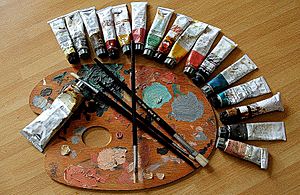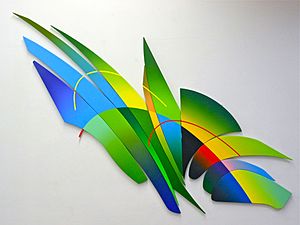Painting facts for kids
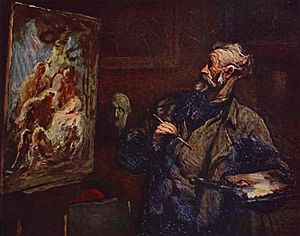
Painting is a way of making art by putting colours onto a surface. It's also the name for the finished artwork itself. Artists use many different kinds of paints. Some common types are watercolors, acrylics, and oils. Other artists might use pencils, chalk, or charcoal.
Many famous paintings are kept in special places called art galleries. For example, the National Gallery in London and the Louvre in Paris. The Louvre is home to one of the most famous paintings in the world, the Mona Lisa, created by Leonardo Da Vinci. You don't always need to visit a huge gallery to see art. Many cities around the world have smaller, private art galleries too.
Painting is different from drawing. When you draw, you usually create the whole image in one go. But in painting, artists often add one layer of paint over another. This means the picture might not look clear until the very end.
There are four main steps in painting:
- Preparation: Most artists get their canvas or surface ready first. They might put a thin, even layer of white or another colour over the whole surface. This helps the later layers stick better and makes the light reflect nicely. For rough surfaces like wood or canvas, a thicker base called gesso is used. Gesso is traditionally made from chalk and gelatin, but today it's often a thick white acrylic. Painting on some surfaces, like plaster, needs a special method called fresco.
- Divide: In this step, the artist divides the canvas into a few main sections. They then sketch out the background for each of these areas.
- Layer: Here, the artist paints one layer over another. This helps to create the right shapes in each section. By the end of this stage, you can clearly see all the objects in the painting.
- Touch-up: This final stage is about adding the finishing touches. This might include making borders precise, blending layers smoothly, and adding other cool visual effects.
Contents
Painting materials and types
Different types of paint are known by what the colour (called pigment) is mixed with. This mixture, or "medium," changes how the paint works. It affects how thick or thin it is, if it mixes with water, and how fast it dries.
Oil paint
Oil painting uses pigments mixed with a drying oil, like linseed oil. This type of paint was very popular in Europe a long time ago. Sometimes, the oil was boiled with tree sap, like pine resin. These mixtures were called 'varnishes' and were liked for their rich look and shine. Oil paint slowly became the main way artists created artworks because of its many benefits. This change started in northern Europe and by the time of the Renaissance, oil paints had mostly replaced tempera paints.
Pastel
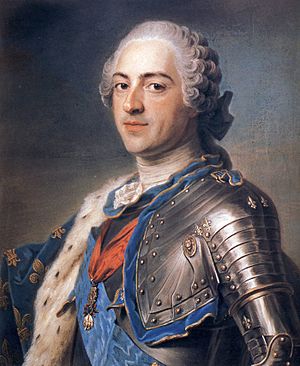
Pastels are like sticks of pure powdered colour mixed with a small amount of glue. The colours in pastels are the same as those used in other art materials, like oil paints. The glue is clear and doesn't change the colour. Pastels give a colour effect that is very close to natural dry pigments. Because pastel paintings can smudge easily, they need to be protected, often by framing them under glass. They can also be sprayed with a fixative to help them last. If made with good pigments and cared for properly, pastel paintings can last for hundreds of years. Unlike paintings made with wet paints, pastels don't usually crack or change colour as they dry.
Acrylic paint
Acrylic paint dries very quickly. It contains colour pigments mixed in a plastic-like liquid called acrylic polymer. You can thin acrylic paints with water, but once they dry, they become waterproof. Depending on how much water or special acrylic gels you add, an acrylic painting can look like a watercolor or an oil painting. It can also have its own unique look that other paints can't create. The biggest difference between most acrylics and oil paints is how fast they dry. Oils dry slowly, which gives artists more time to blend colours. Acrylics dry fast, which means artists can work quickly.
Watercolor
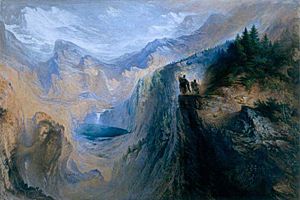
Watercolor is a painting method where the paints are made of colours mixed in a liquid that dissolves in water. The most common surface for watercolor paintings is paper. But artists also use papyrus, bark papers, plastics, vellum (a type of animal skin), leather, fabric, wood, and canvas. In East Asia, watercolor painting with inks is often called brush painting. In China, Korea, and Japanese painting, it has been the main way of painting, often using only black or brown colours. India and Ethiopia also have long traditions of watercolor painting. Finger-painting with watercolors first started in China. You can use watercolor pencils (which are water-soluble coloured pencils) either wet or dry.
Ink
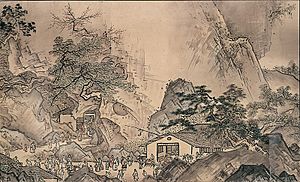
Ink paintings are made with a liquid that has colours or dyes in it. This liquid is used to colour a surface to create an image, text, or design. Artists use ink for drawing with a pen, brush, or quill. Ink can be a complex mix of liquids, colours, dyes, and other materials. These parts help control how the ink flows, its thickness, and how it looks when it dries.
Hot wax or encaustic
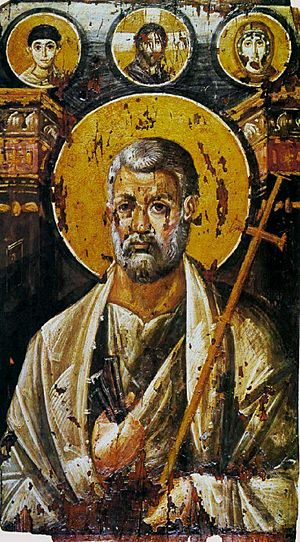
Encaustic painting, also known as hot wax painting, uses heated beeswax mixed with coloured pigments. The melted wax is then put onto a surface, usually prepared wood, but also canvas and other materials. A simple encaustic mix can be just pigments added to beeswax. But there are other recipes that include different types of waxes, tree resin, or linseed oil. You can buy pure powdered pigments, or some mixtures use oil paints or other forms of pigment. Artists use metal tools and special brushes to shape the paint before it cools. They can also use heated metal tools to work with the wax once it has cooled on the surface. Other materials can be pressed into the surface or layered, using the encaustic medium to stick them down.
This method was common for ancient Greek and Roman panel paintings. It was also used in the Eastern Orthodox icon tradition for religious art.
Fresco
Fresco is a type of mural painting done on plaster walls or ceilings. The word "fresco" comes from the Italian word affresco, which means "fresh." Frescoes were very popular during the Renaissance and other early periods.
The Buon fresco method involves painting with colours mixed with water onto a thin layer of wet, fresh lime mortar or plaster. The Italian word for this plaster is intonaco. In contrast, A secco painting is done on dry plaster (secco means "dry" in Italian). For a secco painting, the colours need something to bind them to the wall, like egg (tempera), glue, or oil.
Gouache
Gouache is a water-based paint that contains colour pigments and other materials. It's designed to be used in a way that makes the paint look solid and not see-through. Gouache is different from watercolor because its colour particles are larger. It also has a much higher amount of pigment compared to water. Plus, it often has an extra white pigment, like chalk, which makes it heavier and more opaque. This also gives it more reflective qualities. Like all water-based paints, you can thin gouache with water.
Enamel
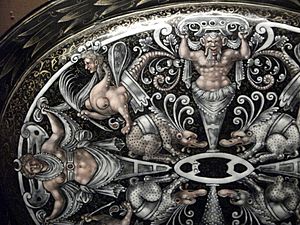
Enamels are made by painting a surface, usually metal, with powdered glass. Special minerals called colour oxides give the enamel its colour. After being heated to very high temperatures (around 750–850 degrees Celsius), the glass and metal melt together. Unlike most painted artworks, the surface of enamel can be touched and even get wet. Enamels have traditionally been used to decorate valuable objects. Limoges enamel was a famous place for enamel painting during the Renaissance. They created small religious and mythical scenes on plaques or items like salt shakers. In the 1700s, enamel painting became very popular in Europe, especially for tiny portrait miniatures. More recently, in the late 1900s, porcelain enamel on metal has been used for strong outdoor murals.
Spray paint
Aerosol paint (also called spray paint) comes in a sealed can that is under pressure. When you press a button, the paint comes out in a fine mist. This type of spray painting leaves a smooth, even layer of paint. Standard spray cans are easy to carry, cheap, and simple to store. You can spray primer directly onto bare metal and many types of plastic.
Because it's fast, portable, and lasts a long time, spray paint is often used for graffiti. In the late 1970s, street graffiti artists started making more detailed signatures and murals. A unique style developed because of how fast you had to work when doing illegal art. Many people now see graffiti and street art as a unique art form. Special spray paints are even made just for graffiti artists. A stencil is a tool that protects a surface, letting paint only go into a specific shape. Stencils can be bought as movable letters, ordered as professionally cut logos, or cut by artists themselves.
Tempera
Tempera, also known as egg tempera, is a strong, fast-drying paint. It's made of coloured pigment mixed with a water-soluble binder (usually a sticky material like egg yolk). Tempera also refers to the paintings made with this type of paint. Tempera paintings last a very long time, and examples from the first centuries CE still exist today. Egg tempera was a main way of painting until after the year 1500, when oil painting became more popular. A paint often called tempera (though it's not true tempera) is made of pigment and glue. This is commonly used and sometimes called poster paint by some companies in America.
Water miscible oil paint
Water miscible oil paints (also called "water soluble" or "water-mixable") are a newer type of oil paint. They are made to be thinned and cleaned up with water, so you don't need to use chemicals like turpentine. You can mix and apply them using the same methods as traditional oil paints. But when they are still wet, you can easily clean them from brushes, palettes, and rags with regular soap and water. They can mix with water because one part of their oil molecule has been changed to connect loosely with water molecules.
Digital painting
Digital painting is a way of creating art using a computer. It can mean making a painting digitally or using a computer to help create a traditional painting. When it's about creating an art object, it uses ideas from traditional painting methods like acrylic paint, oils, ink, or watercolor. But instead of a brush, a computer software program controls industrial robotic machines or printers to put the colour onto surfaces like canvas or paper.
As a technique, digital painting uses a computer graphics program with a virtual canvas and a virtual box of brushes, colours, and other supplies. This virtual box has many tools that don't exist in the real world. These tools give digital artwork a different look and feel compared to art made in the traditional way. It's important to remember that digital painting is not "computer-generated" art. The computer doesn't automatically create images using math. Instead, the artist uses their own painting skills to create the artwork on the computer.
Images for kids
-
The Mona Lisa (1503–1517) by Leonardo da Vinci is one of the world's most famous paintings.
-
An ancient painting of rhinos found in the Chauvet Cave, made 30,000 to 32,000 years ago.
-
The oldest known painting of an animal is this bull. It was found in the Lubang Jeriji Saléh cave in Indonesia and is 40,000 to 52,000 years old.
-
Chen Hongshou (1598–1652), Leaf album painting from the Ming dynasty.
-
Georges Seurat, Circus Sideshow (1887–88).
-
Piet Mondrian, Composition in Red, Yellow, Blue, and Black (1921), at the Gemeentemuseum Den Haag.
-
Nino Pisano, Apelles or the Art of painting (detail) (1334–1336). This is a relief from Giotto's Bell Tower in Florence, Italy.
-
Claude Monet's 1872 painting Impression, Sunrise gave its name to the Impressionist art movement.
-
A 19th Century Mysore Painting of the Goddess Saraswathi.
-
Francisco de Zurbarán, Still Life with Pottery Jars (1636), an oil painting at the Museo del Prado, Madrid.
-
Reza Abbasi, Two Lovers (1630).
-
Andreas Achenbach, Clearing Up, Coast of Sicily (1847), at The Walters Art Museum.
See also
 In Spanish: Pintura para niños
In Spanish: Pintura para niños


